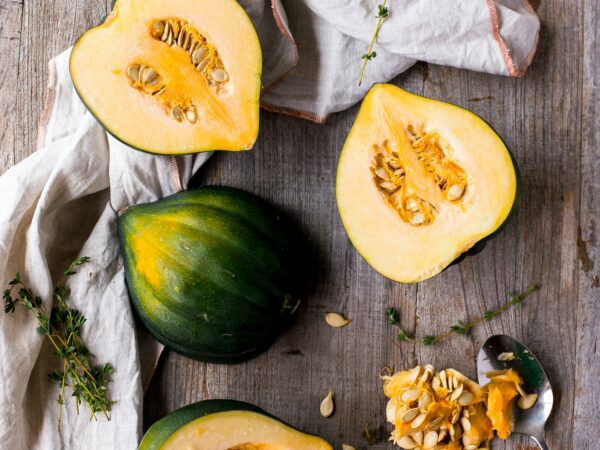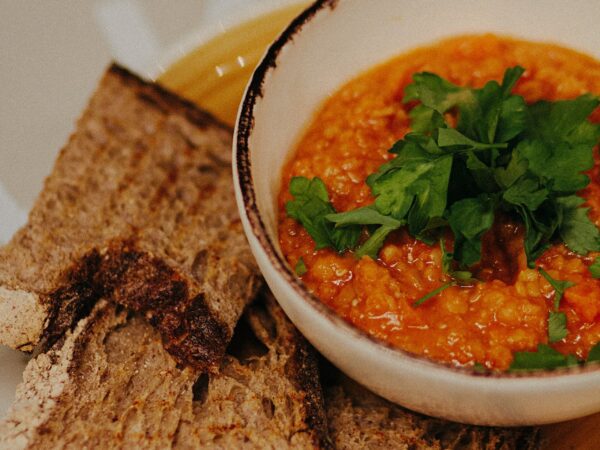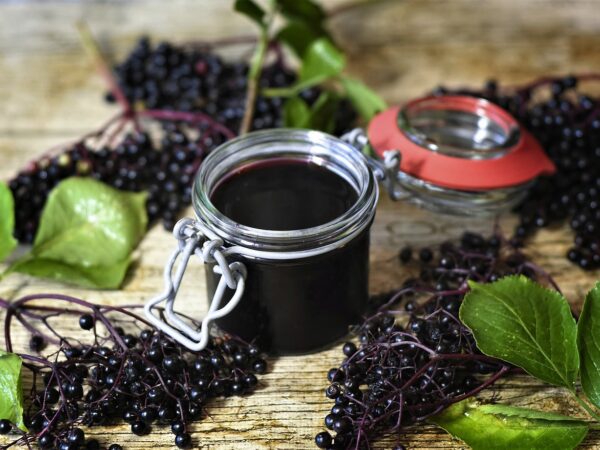Here are some simple ways to make two types of squash, two ways. The varieties of squash for this dish include Acorn and Butternut.
Ingredients
- Butternut Squash
- Acorn Squash
- Coconut Oil
- Rosemary Leaf
- Sprouted Quinoa
- Avocado
- Alfalfa Sprouts
- Extra Virgin Olive Oil
- Basil
- Garlic
- Pink Himalayan Salt
- Black Pepper
Directions
Sprouted Quinoa
The first part of the recipe began the night before – you may also buy sprouted quinoa. I like to soak quinoa the night before I cook it. This allows the quinoa to sprout and also deactivate the enzyme inhibitors. Sprouting quinoa can be achieved very easily by placing raw quinoa in a bowl of clean, non-chlorinated water at room temperature, overnight. Once done, the grains will be noticeably softer and make an excellent addition to salads or other cold meals. You can put it in a cheese cloth or a nut milk bag to drain the water and leave it in the sunlight for a day to allow the quinoa to sprout even more. If you wish to let the sprouts go wild, this process can be repeated for several days. Just remember to rinse the quinoa twice per day and leave in the cheesecloth or nut milk bag.
The science behind the sprouting process and its effect on the seed and the human digestive system is fascinating. Humans do not have the digestive enzymes necessary to break down the fibers contained in grains, nuts, seeds and legumes. Through the sprouting process, gases are released which activate the natural enzymes and release the nutrients, making them available and easier for human digestion. Germinated seeds are easier to digest and the large intestine does not need to produce bacteria to break down the fiber, avoiding the fermentation process which turns the large intestine acid, when it should be alkaline.
All grains and seeds contain enzyme inhibitors that interfere with the absorption of proteins, cause gastric distress, and deficiencies in amino acids. They also contain phytates (phytic acid) which block the intestinal absorption of minerals such as calcium, magnesium, iron, copper and zinc which are necessary for strong bones, teeth and for overall health.
The sprouting process allows enzymes, lactobacilli and other helpful organisms neutralize phytic acid, remove enzyme inhibitors and break down complex starches.
The quinoa will cook quickly since it has been sprouted overnight. Add a little bit of coconut oil to a pan with rosemary. Let the rosemary slowly cook in the oil. Once it appears to be lightly browning, add in chopped garlic and let cook for 3 mins in the coconut oil. Add the sprouted quinoa and just enough water to cover the bottom of the pan, the quinoa should not be covered. Heat is still medium. Keep stirring throughout and add in chopped basil, pink Himalayan salt and black pepper. Fluff to finish.
Butternut Squash
Next step in the recipe is to cut the tips off the butternut squash, chop in half the long way, then remove seeds. Take the skin off, easiest with a peeler. Chop into small cubes and place into a large pan. Add a small amount of Coconut oil to the pan. Next, add in rosemary leaf and cook on medium for 10 mins, stirring every couple of minutes. Once the squash is close to being done, or soft, toss in chopped garlic. The garlic will cook in 5 mins or less at medium heat, which will allow the flavor to be released into the squash without overcooking it.
Acorn Squash
While the butternut squash is cooking, preheat the oven to 350. Chop the tips off the acorn squash, just enough so that it sits flat on a baking tray. Halve the acorn squash and clean out the seeds. Add a small amount of coconut oil to each half. Put the Squash in the oven for approx. 20 – 30 mins. If you like, finish them off in the broiler to brown the tops.
Wilted Kale
Add chopped purple kale to another pan and put on light heat to wilt. Lightly salt and pepper.
Plating
Butternut Squash
To plate the butternut squash dish, you can achieve a simple and beautiful layering effect by using a small bowl. Start with the butternut squash on the bottom. Next put the kale, followed by the quinoa. Press the quinoa down so that all the ingredients are pressed tightly into the bowl. Cover the bowl with a plate and flip upside down, give it a few taps on the bottom of the bowl to release and remove. Garnish with avocado and sprouts. Finish off with light salt, pepper and extra virgin olive oil.
Acorn Squash
Once the acorn squash is done, remove from oven and fill with the cooked quinoa. Top with sliced avocado and add light salt and pepper. Finish with a light drizzle of Extra Virgin Olive Oil.
Vallaha, there you have it, all squashed up. Buen Provecho.
Health Benefits
Butternut Squash
When shopping for butternut squash (technically a fruit), look for a matte color on the skin. A squash with a shiny skin indicates that it was picked to early. No need to refrigerate the squash, just place in a well-ventilated area and it will keep for up to 3 months. Up to a week if cut up and covered in the fridge
The most notable befits of butternut squash are in it’s color. The color signals an abundance of powerhouse nutrients known as carotenoids, shown to protect against heart disease. In particular, the gourd boasts very high levels of beta-carotene (which your body converts to vitamin A) and one cup of butternut squash contains 50% of the recommended daily dose of antioxidant rich vitamin C.
And in case you aren’t already sold, butternut squash has been shown to be a very powerful anti-inflammatory, making this fruit great for athletes as well as people suffering from disorders like rheumatoid arthritis and asthma.
Acorn Squash
Acorn squash contains vitamin A, niacin, folate, thiamine and vitamin B-6, but it is an especially good source of vitamin C. One half cup of cooked acorn squash provides about 20 percent of the recommended daily intake of vitamin C. Adequate vitamin C promotes the health of the immune and skeletal systems and may help prevent hypertension, heart disease, cancer and osteoarthritis. The vitamin C content of foods is degraded by exposure to air, light, heat and water. To maximize the amount of vitamin C you receive from acorn squash, use the fruit three to four days after purchase and cut immediately before cooking. Steam or bake the squash instead of boiling it to keep vitamin C from being lost in the cooking water.
Each half-cup serving of acorn squash contains 13 percent of the recommended daily intake of potassium and 11 percent of that for magnesium. As both a mineral and an electrolyte, potassium plays a vital role in muscle contraction and in maintaining the body’s water balance. Magnesium regulates potassium levels, strengthens bones and teeth, and aids in proper energy metabolism. Regularly eating potassium- and magnesium-rich foods like acorn squash, can lessen your chance of stroke, osteoporosis, depression and diabetes. Acorn squash also contains small amounts of iron, calcium, zinc and phosphorus.
By Adam Kenworthy
Adam’s passion and appreciation for cooking arose from his love for extreme sports. Having participated in many tests of physical and mental endurance he quickly realized the impact a healthy and well balanced diet played on his overall performance. Adam began to study various aspects of plant based diets, holistic remedies, and culinary techniques from around the world. Through the use of organic, farm-to-table ingredients, Adam hopes to inspire many to reconsider their current eating habits and direct them toward a more sustainable lifestyle. He believes that conscious eating is the key to living a more healthy and vibrant co-existence with Mother Nature.

Learn More from Adam on Omstars










